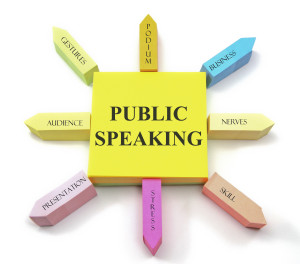Speech Tips
End Your Presentation With A Bang
End Your Presentation With A Bang
The end of a presentation, especially at a luncheon, needs to feel like dessert – sweet and satisfying.
Show your enthusiasm through lively gestures, facial expressions, and speech volume.
Restate your viewpoint. Send them back to work with a lift.
Rerun from Aug 8, 2016
English communication skills- Networking- Relationships- Power of Praise and Thanks
English communication skills- Networking- Relationships- Power of Praise and Thanks
Dear all–
Thanksgiving in the USA comes on the last Thursday in the month of November.
And… it is soooo good to thank people around us for all that they do– every day, not just on national holidays of Thanksgiving, whether in the USA or other national days of gratitude.
So, I, Dr. Johnson am running today this blog about praising and thanks — especially for networking and building relationships. It originally ran on November 12, 2014.
Make it giving generous praise and thanks a habit!
—
An attitude of gratitude nourishes your network and relationships and helps it blossom in its growing.
Think about all the people who support you personally and professionally. Praise is the act of giving positive and sincere feedback and support to those people.
You can’t just tell people once that you appreciate them. Appreciation and caring must be expressed in a sincere, consistent manner.
There are two main ways to regularly acknowledge people in your network:
- By speaking to them either in person or on the telephone
- By sending them notes
Here are some tips on speaking words of praise and verbal acknowledgment:
- Let people know immediately that you notice and appreciate what they are doing. So at the end of phone conversations, thank people for their call, time and feedback.
- At the end of meetings, take the last few moments as a time for acknowledgments, when anyone can verbally express appreciation to anyone else in the meeting.
- Give acknowledgments directly by looking people in the eye. Make sure you get their attention. Don’t mumble or act as if your comment is unimportant. Say it with a strong voice and with sincerity.
“Sue, I appreciate the way you…”
- Be specific. When you make a general acknowledgment, some people may say, “She says this to everyone.” Instead, be direct about what you appreciate in the other person. This personal approach communicates sincerity and warmth and is more likely to catch their attention.
“Mike, I noticed how you responded to that client. I sure liked the way you listened and tried to take care of her concern so that she felt taken care of.”
- Acknowledge people for what they do AND for the characteristics and qualities they show. Give positive feedback about their values, strengths, and abilities, as well as the way they are using those strengths and skills to get things done.
“Congratulations on your new venture. I admire your courage to go forth on your own.”
“Thanks for referring Maria to me. We had a great conversation right away and I look forward to working with her firm. I sure appreciate having you as a powerful resource in my life.”
“Thanks for your hospitality. I so enjoyed my visit. You are such a gracious host.”
The second way to express thanks and gratitude is via notes.
Be sure to watch our English Speech Tips videos and Accent Reduction Tip videos for more English pronunciation and accent reduction exercise.
Check out our new advanced weekly speech tip program, our new subscription called ClearTalk Weekly, www.subscription.cleartalkmastery.com
Rerun from July 6, 2016
Grab Audience Attention with Shocker Sentence
Grab Audience Attention with Shocker Sentence
Use this very effective way to get attention of an audience, especially at a luncheon. Make a statement that surprises, startles, or challenges them.
Example: “The organization is going to change in ways you can hardly imagine over the next six months.”
Here are the three rules to make this technique work effectively.
- The statement should be one sentence only.
- It should hint at information that intrigues or shocks the listener and makes them want to hear more.
- It should dramatize the topic of the discussion.
Rerun from Aug 1, 2016
Accent Reduction – Habit Success – The Other Secret is Forgive Yourself
Accent Reduction – Habit Success – The Other Secret is Forgive Yourself
You are going to fail sometimes. That’s okay,
Richard Wiseman studied people who achieved their goals. From those investigations, he realized we should:
- Expect to go back to your old habits sometimes. Treat that failure as a temporary set-back, and go forward.
What does science say we should do when we divert from our goal or procrastinate and put off doing the habit we want? Forgive yourself and move on.
Study after study show that self-criticism is consistently associated with less motivation and worse consistency of action.
Self criticism is also one of the single biggest predictors of depression, which saps away both perseverance and desire to attain a goal (“I want”).
On the other hand, self-compassion – being supportive and kind to yourself, especially as you face stress and failure – is associated with more motivation and consistency of action.
In trying to do anything to make your life better, it is okay to stumble and not succeed sometimes. It takes time. Habit takes time. Learning takes time.
Be sure to watch our English Speech Tips videos and Accent Reduction Tip videos for more English pronunciation and accent reduction exercise.
Check out our new advanced weekly speech tip program, our new subscription called ClearTalk Weekly, www.subscription.cleartalkmastery.com
Rerun from June 29, 2016
How to Tell a Story
How to Tell a Story
- Start at a point in time. Remember, the most memorable stories in any culture start with some variation of “once upon a time” the same way a fairy tale begins.
- Don’t explain the story. Re-create it the way it happened. Use dialogue. Add rich detail so the audience sees what you saw, hears what you heard, feels what you felt. Then make your point, tying it back to your overall message.
Rerun from July 25, 2016












